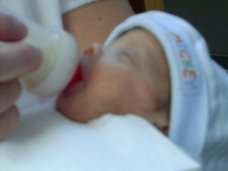We spoke with the eye surgeons yesterday afternoon. She has Stage 3 Retinopathy of Prematurity in both eyes and Plus disease.
This is a definition of ROP - Retinopathy of prematurity (ROP) is a potentially blinding eye disorder that primarily affects premature infants weighing about 2¾ pounds (1250 grams) or less that are born before 31 weeks of gestation (A full-term pregnancy has a gestation of 38–42 weeks). The smaller a baby is at birth, the more likely that baby is to develop ROP. This disorder—which usually develops in both eyes—is one of the most common causes of visual loss in childhood and can lead to lifelong vision impairment and blindness. ROP was first diagnosed in 1942.Today, with advances in neonatal care, smaller and more premature infants are being saved. These infants are at a much higher risk for ROP. Not all babies who are premature develop ROP. There are approximately 3.9 million infants born in the U.S. each year; of those, about 28,000 weigh 2¾ pounds or less. About 14,000–16,000 of these infants are affected by some degree of ROP. The disease improves and leaves no permanent damage in milder cases of ROP. About 90 percent of all infants with ROP are in the milder category and do not need treatment. However, infants with more severe disease can develop impaired vision or even blindness.
About 1,100–1,500 infants annually develop ROP that is severe enough to require medical treatment. About 400–600 infants each year in the US become legally blind from ROP.
Stage I — Mildly abnormal blood vessel growth. Many children who develop stage I improve with no treatment and eventually develop normal vision. The disease resolves on its own without further progression.
Stage II — Moderately abnormal blood vessel growth. Many children who develop stage II improve with no treatment and eventually develop normal vision. The disease resolves on its own without further progression.
This is what Kaitlyn has Stage III — Severely abnormal blood vessel growth. The abnormal blood vessels grow toward the center of the eye instead of following their normal growth pattern along the surface of the retina. Some infants who develop stage III improve with no treatment and eventually develop normal vision. However, when infants have a certain degree of Stage III and "plus disease" develops, treatment is considered. "Plus disease" means that the blood vessels of the retina have become enlarged and twisted, indicating a worsening of the disease. Treatment at this point has a good chance of preventing retinal detachment.
Stage IV — Partially detached retina. Traction from the scar produced by bleeding, abnormal vessels pulls the retina away from the wall of the eye.
Stage V — Completely detached retina and the end stage of the disease. If the eye is left alone at this stage, the baby can have severe visual impairment and even blindness
The surgeons are going to perform a new procedure on her where they will inject an "antibody" into her eyes. A week after the procedure they will look at her eyes again to see if the procedure worked. I know that God, our divine healer, has her in his hands.
Tuesday, July 25, 2006
Subscribe to:
Post Comments (Atom)
Born Too Soon

Kaitlyn
Born Too Soon

Grayson
No comments:
Post a Comment